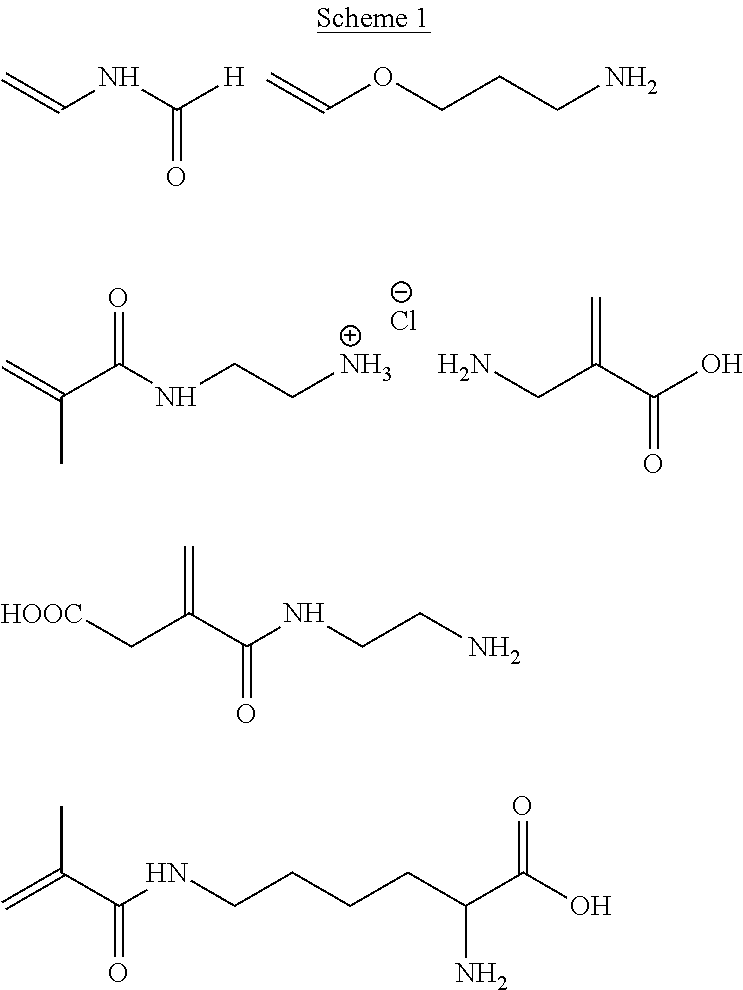Aqueous dental glass ionomer composition
a technology of dental glass and ionomer, applied in dental prosthetics, dental impression caps, dentistry, etc., can solve the problems of brittleness, low flexural strength of conventional glass ionomer cement, and introduction of a further polymerizable moiety, so as to improve mechanical properties and high flexural strength
- Summary
- Abstract
- Description
- Claims
- Application Information
AI Technical Summary
Benefits of technology
Problems solved by technology
Method used
Image
Examples
example 1
1. Copolymerisation of tert.-Butylacrylat (tButA) and 3-Aminopropylvinylether (APVE) to poly(tButA-co-APVE)
[0267]
[0268]5.0 g (39 mmol) tButA, 0.99 g (9.8 mmol, 20 mol-%) APVE and 0.16 g (2 mol-%) AIBN were separately dissolved in DMF and the solutions were saturated with N2. Then the solutions were combined and stirred for 24 h at 70° C. After the polymerization the cooled solution was diluted with DMF to 30 wt-% polymer solutions and precipitated in water / methanol (9:1). The separated solid was dried in vacuum.
[0269]The obtained copolymer had a molecular weight Mn=18 kDa, an Mw=51 kDa and a PD of 2.8.
[0270]IR-spectroscopy of the product showed no vinylether-vibrations while 1H-NMR showed broadened peaks for the aliphatic protons and no peaks for possible remaining double bond protons.
[0271]1H-NMR (500 MHz, DMSO-d6): δ (ppm)=3.5 (2H, 4), 2.7 (2H, 6), 2.2 (2H, 2), 1.8 (1H, 1), 1.6 (2H, 5), 1.44 (9H, 3).
2. Methacrylation of the Poly(tButA-Co-APVE)
[0272]
[0273]To a solution of 5 g (33.7...
example 2
1. Copolymerization of tert butyl acrylate (t-BA) and 3-aminopropyl vinylether (APVE) to poly(AA-co-APVE)
[0278]In a three necked round bottom flask, equipped with a cooler, 2.34 mL (0.0206 mol) APVE and 8.97 mL (0.0618 mol) t-BA were mixed with 20 mL dioxane. 278 mg AIBN (2 mol-% regarding the total monomers) were dissolved, too. The reaction mixture was instantaneously flushed with Argon for about 20 min. Meanwhile a metal bath was preheated to 90° C. The polymerization was instantaneously started by placing the bath below the flask. After 1 h of stirring the reaction was complete. A sample of 5 mL was withdrawn and diluted with dioxane to 20 mL. The polymer was precipitated by adding this solution to an excess of 150 mL water. The polymer was dried at the vacuum pump. The molecular weight was determined by using SEC with DMF as eluent.
[0279]Mn=11500 g / mol, Mw=38100 g / mol, PD=3.32
2. Modification of Poly(AA-Co-APVE) with Methacrylic Anhydride
[0280]To the residue of the reaction mixt...
example 3
Copolymerisation of tert.-Butylacrylate and 3-Aminopropylvinylether —P(tBu-co-APVE)
[0282]A solution of 15 g (117 mmol) tert.-Butylacrylat in 38 g DMF was saturated under ice cooling with nitrogen. 3 g (29 mmol) 3-Amino-propylvinylether were added to this solution after 15 minutes. Further 5 minutes later were added 480 mg (2 mol-%) AIBN in nitrogen counter flow. Then the solution was stirred for 24 h at 70° C. After the polymerization the cooled solution was diluted with DMF to 33 wt-% polymer solutions and precipitated in the 20-fold quantity of water. The solid was filtered off, washed with water and dried in vacuum.
[0283]FT-IR: νmax [cm−1]=2977 (—CH2—), 1723 (ester), 1481, 1449, 1392, 1366, 1255, 1144, 845.
[0284]1H-NMR (500 MHz, CDCl3): δ (ppm)=3.5 (2H, —O—CH2—), 2.7 (2H, —CH2—NH2), 2.2 (2H, backbone), 1.8 (1H, backbone), 1.6 (2H, —O—CH2—CH2—), 1.44 (9H, -tbutyl).
[0285]GPC (DMF): Mn=26 kDa, Mw=70 kDa, Mz=124 kDa, PD=2.7.
[0286]The following table shows typical molecular masses for...
PUM
| Property | Measurement | Unit |
|---|---|---|
| molecular weight | aaaaa | aaaaa |
| molecular weight Mw | aaaaa | aaaaa |
| adhesive bond strength | aaaaa | aaaaa |
Abstract
Description
Claims
Application Information
 Login to View More
Login to View More - R&D
- Intellectual Property
- Life Sciences
- Materials
- Tech Scout
- Unparalleled Data Quality
- Higher Quality Content
- 60% Fewer Hallucinations
Browse by: Latest US Patents, China's latest patents, Technical Efficacy Thesaurus, Application Domain, Technology Topic, Popular Technical Reports.
© 2025 PatSnap. All rights reserved.Legal|Privacy policy|Modern Slavery Act Transparency Statement|Sitemap|About US| Contact US: help@patsnap.com



